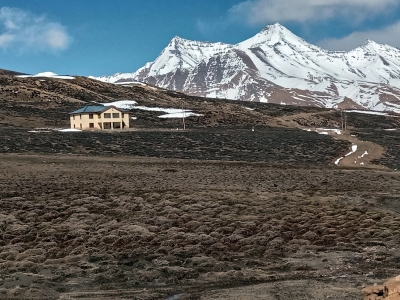Shimla: Braving rarefied air and cold temperatures, when plains in northern India are reeling under a debilitating heatwave, voters in high-altitude Himalayan hamlets of Himachal Pradesh are gung ho about exercising their franchise on June 1.
A testament to the dedication to keep democracy alive, the world’s highest polling station Tashigang, located at a height of 15,256 feet above sea level, in the Spiti Valley, which is part of the Mandi parliamentary constituency, has 52 registered voters, comprising 30 men and 22 women.
“We are excited to cast our vote for a better future and a better life for generations to come,” remarked Tashigang resident Tenzin Lundup.
“Like the last elections (2022 Assembly polls), the polling station in Tashigang would again record 100 per cent polling,” added first-time voter, Kalzang Rinchen, a postgraduate preparing for exams for a government job.
The Lahaul-Spiti District has the lowest number of electorate — 25,273 — in the state, while Kinnaur has 59,943 voters.
The climatic conditions in these districts are harsh as much of the land falls under a cold desert.
The Election Commission of India (ECI) has set up 92 polling stations in Lahaul-Spiti, while in Kinnaur there will be 128 polling stations.
“Polling is a difficult exercise in Lahaul-Spiti, Kinnaur and Chamba as one-third of the polling booths are located at altitudes above 13,000 feet.
“The polling material has reached almost all polling stations. In some stations, staff will be airlifted from district headquarters a day before polling,” an election officer told IANS.
He said a majority of polling stations in Lahaul-Spiti and Kinnaur are connected by road.
Electronic Voting Machines (EVMs) and Voter Verifiable Paper Audit Trail (VVPAT) machines for Kaza, some 320 kms from state capital Shimla, were dropped by a helicopter of the Indian Air Force (IAF) on May 27.
The Spiti Valley has 29 polling stations. Thirteen gram panchayats fall in the Spiti Valley, mainly populated by tribals, who are largely Buddhist farmers.
The gram panchayats are Losar, Kibber, Kaza, Langcha, Demul, Lalung, Dhankar, Tabo, Gue, Hal, Khurik, Kungri and Saganam.
Another remote place in the state is the landlocked Pangi Valley in Chamba District. The Saach Pass is the gateway to the picturesque Pangi Valley.
Located at an altitude of 14,500 feet in Chamba District, it’s still closed for motorists after the winter snowfall.
Resident Commissioner Ritika Jindal, the first woman officer to opt for the Pangi posting, told IANS the material for 39 polling stations has reached Killar, the subdivisional headquarters of Pangi, located in the Pir-Panjal range of the Himalayas, via an IAF helicopter.
The Saach Pass, the shortest road link between Chamba town, some 450 km from the state capital, and Killar is expected to reopen in the first week of July.
The Chask Bhatori and Kulal polling stations are the remotest in the Pangi Valley, where election officials will have to walk a distance of at least 14 km to conduct the poll. The valley last saw snowfall on May 2.
Lahaul-Spiti, along with other remote areas of Kinnaur District and Pangi and Bharmour subdivisions of Chamba District, are part of the sprawling Mandi constituency that covers almost two-thirds of the state.
In Mandi, Congress legislator Vikramaditya Singh, the scion of the erstwhile royal family, challenges actress Kangana Ranaut of the BJP.
A majority of the booths are scattered over rugged, cold and inhospitable terrain and poll officials have to trek hours to reach there.
Locals are largely Buddhist farmers who grow barley, potatoes, wheat and black peas.
Before 2019, the highest polling station was Hikkim (14,400 feet) located close to Tashigang. But in 2019, Tashigang was made a polling station.
The state Election Commission has also decided to set up one of the state’s remotest polling stations at Bara Bhangal in Kangra District at an altitude of over 2,800 metres not accessible by road. It falls in the Baijnath Assembly constituency that is part of the Kangra parliamentary seat.
Situated between the mighty Dhauladhar and Pir Panjal ranges of the Himalayas, Bara Bhangal is considered to be the remotest village with 469 electorates.
An official with the Election Commission told IANS the polling station of Bara Bhangal has been set up in Bir, where now 310 voters will exercise their franchise.
Owing to the difficult geographical conditions of the area, an auxiliary polling station will also be set up in Bara Bhangal where the remaining 159 voters will cast their votes.
The election official said since most trekking routes leading to Bara Bhangal are blocked by winter snow, helicopter is the only mode of transportation to reach there. However, Bara Bhangal is accessible on foot through the Thamsar Pass, located at an altitude of 4,700 metres.
The state ruling Congress has fielded its veteran and four-time Rajya Sabha MP Anand Sharma in his new battleground Kangra, the largest Lok Sabha constituency in terms of voters, against Rajiv Bhardwaj of the BJP, which ignored the sitting MP, Kishan Kapoor.
The Swar polling station in Mandi’s Chuhar Valley is located at a distance of 12 km from the road. The valley is infamous for cultivation of opium.
Polling for the four Lok Sabha seats in Himachal Pradesh — Shimla (Reserved), Kangra, Mandi and Hamirpur — is scheduled for June 1.
(Vishal Gulati can be contacted at gulatiians@gmail.com)
–IANS


Comments are closed.